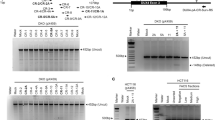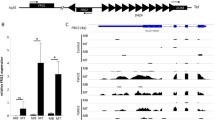Abstract
The degenerative muscle disorder facioscapulohumeral dystrophy (FSHD) is thought to be caused by the inappropriate expression of the Double Homeobox 4 (Dux4) protein in muscle cells leading to apoptosis. Expression of Dux4 in the major form of FSHD is a function of two contributing molecular changes: contractions in the D4Z4 microsatellite repeat region where Dux4 is located and an SNP present within a region downstream of the D4Z4. This SNP provides a functional, yet non-consensus polyadenylation signal (PAS) is used for the Dux4 mRNA 3′ end processing. Surprisingly, the sequences flanking the Dux4 PAS do not resemble a typical cleavage and polyadenylation landscape with no recognizable downstream sequence element and a suboptimal cleavage site. Here, we conducted a systematic analysis of the cis-acting elements that govern Dux4 cleavage and polyadenylation. Using a transcriptional read-through reporter, we determined that sequences downstream of the SNP located within the β-satellite region are critical for Dux4 cleavage and polyadenylation. We also demonstrate the feasibility of using antisense oligonucleotides to target these sequences as a means to reduce Dux4 expression. Our results underscore the complexity of the region immediately downstream of the D4Z4 and uncover a previously unknown function for the β-satellite region in Dux4 cleavage and polyadenylation.





Similar content being viewed by others
References
Bagga PS, Arhin GK, Wilusz J (1998) DSEF-1 is a member of the hnRNP H family of RNA-binding proteins and stimulates pre-mRNA cleavage and polyadenylation in vitro. Nucleic Acids Res 26:5343–5350
Barzaghi F, Passerini L, Bacchetta R (2012) Immune dysregulation, polyendocrinopathy, enteropathy, x-linked syndrome: a paradigm of immunodeficiency with autoimmunity. Front Immunol 3:211. doi:10.3389/fimmu.2012.00211
Bennett CL, Brunkow ME, Ramsdell F, O’Briant KC, Zhu Q, Fuleihan RL, Shigeoka AO, Ochs HD, Chance PF (2001) A rare polyadenylation signal mutation of the FOXP3 gene (AAUAAA–>AAUGAA) leads to the IPEX syndrome. Immunogenetics 53:435–439. doi:10.1007/s002510100358
Bonano VI, Oltean S, Garcia-Blanco MA (2007) A protocol for imaging alternative splicing regulation in vivo using fluorescence reporters in transgenic mice. Nat Protoc 2:2166–2181. doi:10.1038/nprot.2007.292
Bosnakovski D, Xu Z, Gang EJ, Galindo CL, Liu M, Simsek T, Garner HR, Agha-Mohammadi S, Tassin A, Coppee F, Belayew A, Perlingeiro RR, Kyba M (2008) An isogenetic myoblast expression screen identifies DUX4-mediated FSHD-associated molecular pathologies. EMBO J 27:2766–2779. doi:10.1038/emboj.2008.201
Chen F, MacDonald CC, Wilusz J (1995) Cleavage site determinants in the mammalian polyadenylation signal. Nucleic Acids Res 23:2614–2620
Chen JC, King OD, Zhang Y, Clayton NP, Spencer C, Wentworth BM, Emerson CP, Wagner KR (2016) Morpholino-mediated knockdown of DUX4 toward facioscapulohumeral muscular dystrophy therapeutics. Mol Ther 24:1405–1411
Danckwardt S, Hentze MW, Kulozik AE (2008) 3′ End mRNA processing: molecular mechanisms and implications for health and disease. EMBO J 27:482–498. doi:10.1038/sj.emboj.7601932
Daxinger L, Tapscott SJ, van der Maarel SM (2015) Genetic and epigenetic contributors to FSHD. Curr Opin Genet Dev 33:56–61. doi:10.1016/j.gde.2015.08.007
Gehring NH, Frede U, Neu-Yilik G, Hundsdoerfer P, Vetter B, Hentze MW, Kulozik AE (2001) Increased efficiency of mRNA 3′ end formation: a new genetic mechanism contributing to hereditary thrombophilia. Nat Genet 28:389–392. doi:10.1038/ng578
Giussani M, Cardone MF, Bodega B, Ginelli E, Meneveri R (2012) Evolutionary history of linked D4Z4 and Beta satellite clusters at the FSHD locus (4q35). Genomics. doi:10.1016/j.ygeno.2012.07.011
Hu J, Lutz CS, Wilusz J, Tian B (2005) Bioinformatic identification of candidate cis-regulatory elements involved in human mRNA polyadenylation. RNA 11:1485–1493
Lemmers RJFL, Wohlgemuth M, Frants RR, Padberg GW, Morava E, van der Maarel SM (2004) Contractions of D4Z4 on 4qB subtelomeres do not cause facioscapulohumeral muscular dystrophy. Am J Human Genet 75:1124–1130. doi:10.1086/426035
Lemmers RJLF, van der Vliet PJ, Klooster R, Sacconi S, Camaño P, Dauwerse JG, Snider L, Straasheijm KR, van Ommen GJ, Padberg GW, Miller DG, Tapscott SJ, Tawil R, Frants RR, van der Maarel SM (2010a) A unifying genetic model for facioscapulohumeral muscular dystrophy. Science (New York, NY) 329:1650–1653
Lemmers RJLF, van der Vliet PJ, van der Gaag KJ, Zuniga S, Frants RR, de Knijff P, van der Maarel SM (2010b) Worldwide population analysis of the 4q and 10q subtelomeres identifies only four discrete interchromosomal sequence transfers in human evolution. Am J Hum Genet 86:364–377. doi:10.1016/j.ajhg.2010.01.035
Lemmers RJLF, Tawil R, Petek LM, Balog J, Block GJ, Santen GWE, Amell AM, van der Vliet PJ, Almomani R, Straasheijm KR, Krom YD, Klooster R, Sun Y, den Dunnen JT, Helmer Q, Donlin-Smith CM, Padberg GW, van Engelen BGM, de Greef JC, Aartsma-Rus AM, Frants RR, de Visser M, Desnuelle C, Sacconi S, Filippova GN, Bakker B, Bamshad MJ, Tapscott SJ, Miller DG, van der Maarel SM (2012) Digenic inheritance of an SMCHD1 mutation and an FSHD-permissive D4Z4 allele causes facioscapulohumeral muscular dystrophy type 2. Nature Genet 44:1370–1374
Marsollier A-C, Ciszewski L, Mariot V, Popplewell L, Voit T, Dickson G, Dumonceaux J (2016) Antisense targeting of 3′end elements involved in DUX4 mRNA processing is an efficient therapeutic strategy for facioscapulohumeral dystrophy: a new gene silencing approach. Hum Mol Genet. doi:10.1093/hmg/ddw015
Marzluff WF, Wagner EJ, Duronio RJ (2008) Metabolism and regulation of canonical histone mRNAs: life without a poly(A) tail. Nat Rev Genet 9:843–854
Orkin SH, Cheng TC, Antonarakis SE, Kazazian HH Jr (1985) Thalassemia due to a mutation in the cleavage-polyadenylation signal of the human beta-globin gene. EMBO J 4:453–456
Peart N, Wagner EJ (2016) Gain-of-function reporters for analysis of mRNA 3′-end formation: design and optimization. Biotechniques 60:137–140. doi:10.2144/000114390
Proudfoot NJ (2011) Ending the message: poly(A) signals then and now. Genes Dev 25:1770–1782
Ricci G, Scionti I, Sera F, Govi M, D’Amico R, Frambolli I, Mele F, Filosto M, Vercelli L, Ruggiero L, Berardinelli A, Angelini C, Antonini G, Bucci E, Cao M, Daolio J, Di Muzio A, Di Leo R, Galluzzi G, Iannaccone E, Maggi L, Maruotti V, Moggio M, Mongini T, Morandi L, Nikolic A, Pastorello E, Ricci E, Rodolico C, Santoro L, Servida M, Siciliano G, Tomelleri G, Tupler R (2013) Large scale genotype-phenotype analyses indicate that novel prognostic tools are required for families with facioscapulohumeral muscular dystrophy. Brain J Neurol 136:3408–3417. doi:10.1093/brain/awt226
Richards M, Coppée F, Thomas N, Belayew A, Upadhyaya M (2012) Facioscapulohumeral muscular dystrophy (FSHD): an enigma unravelled? Hum Genet 131:325–340. doi:10.1007/s00439-011-1100-z
Scionti I, Greco F, Ricci G, Govi M, Arashiro P, Vercelli L, Berardinelli A, Angelini C, Antonini G, Cao M, Di Muzio A, Moggio M, Morandi L, Ricci E, Rodolico C, Ruggiero L, Santoro L, Siciliano G, Tomelleri G, Trevisan CP, Galluzzi G, Wright W, Zatz M, Tupler R (2012) Large-scale population analysis challenges the current criteria for the molecular diagnosis of fascioscapulohumeral muscular dystrophy. Am J Hum Genet 90:628–635
Sheets MD, Ogg SC, Wickens MP (1990) Point mutations in AAUAAA and the poly (A) addition site: effects on the accuracy and efficiency of cleavage and polyadenylation in vitro. Nucleic Acids Res 18:5799–5805
Shi Y, Manley JL (2015) The end of the message: multiple protein–RNA interactions define the mRNA polyadenylation site. Genes Dev 29:889–897. doi:10.1101/gad.261974.115
Shi Y, Di Giammartino DC, Taylor D, Sarkeshik A, Rice WJ, Yates JR 3rd, Frank J, Manley JL (2009) Molecular architecture of the human pre-mRNA 3′ processing complex. Mol Cell 33:365–376. doi:10.1016/j.molcel.2008.12.028
Snider L, Geng LN, Lemmers RJLF, Kyba M, Ware CB, Nelson AM, Tawil R, Filippova GN, van der Maarel SM, Tapscott SJ, Miller DG (2010) Facioscapulohumeral dystrophy: incomplete suppression of a retrotransposed gene. PLoS Genet 6:e1001181
Tawil R, Van Der Maarel SM (2006) Facioscapulohumeral muscular dystrophy. Muscle Nerve 34:1–15. doi:10.1002/mus.20522
Tian B, Graber JH (2012) Signals for pre-mRNA cleavage and polyadenylation. Wiley interdisciplinary reviews. RNA 3:385–396. doi:10.1002/wrna.116
van Geel M, Dickson MC, Beck AF, Bolland DJ, Frants RR, van der Maarel SM, de Jong PJ, Hewitt JE (2002) Genomic analysis of human chromosome 10q and 4q telomeres suggests a common origin. Genomics 79:210–217. doi:10.1006/geno.2002.6690
van Overveld PGM, Lemmers RJFL, Sandkuijl LA, Enthoven L, Winokur ST, Bakels F, Padberg GW, van Ommen G-JB, Frants RR, van der Maarel SM (2003) Hypomethylation of D4Z4 in 4q-linked and non-4q-linked facioscapulohumeral muscular dystrophy. Nat Genet 35:315–317. doi:10.1038/ng1262
Wijmenga C, Hewitt JE, Sandkuijl LA, Clark LN, Wright TJ, Dauwerse HG, Gruter AM, Hofker MH, Moerer P, Williamson R (1992) Chromosome 4q DNA rearrangements associated with facioscapulohumeral muscular dystrophy. Nat Genet 2:26–30. doi:10.1038/ng0992-26
Xiang K, Tong L, Manley JL (2014) Delineating the structural blueprint of the pre-mRNA 3′-end processing machinery. Mol Cell Biol 34:1894–1910. doi:10.1128/MCB.00084-14
Yang Q, Doublié S (2011) Structural biology of poly(A) site definition. Wiley interdisciplinary reviews. RNA 2:732–747
Zarkower D, Wickens M (1988) A functionally redundant downstream sequence in SV40 late pre-mRNA is required for mRNA 3′-end formation and for assembly of a precleavage complex in vitro. J Biol Chem 263:5780–5788
Zarkower D, Stephenson P, Sheets M, Wickens M (1986) The AAUAAA sequence is required both for cleavage and for polyadenylation of simian virus 40 pre-mRNA in vitro. Mol Cell Biol 6:2317–2323
Zhao J, Hyman L, Moore C (1999) Formation of mRNA 3′ Ends in Eukaryotes: mechanism, regulation, and interrelationships with other steps in mRNA synthesis. Microbiol Mol Biol Rev 63:405–445
Zhu H, Zhou HL, Hasman RA, Lou H (2007) Hu proteins regulate polyadenylation by blocking sites containing U-rich sequences. J Biol Chem 282:2203–2210. doi:10.1074/jbc.M609349200
Acknowledgements
This work was supported by the Muscular Dystrophy Foundation (MDA 202141), Friends of FSH Research, and a Schissler Foundation Fellowship for Translational Studies of Common Human Diseases.
Author information
Authors and Affiliations
Contributions
NP performed the experiments and data analyses, and wrote the manuscript. EJW conceived the project and contributed to the design of the experiments, and manuscript writing.
Corresponding author
Ethics declarations
Conflict of interests
The authors declare no competing interests
Rights and permissions
About this article
Cite this article
Peart, N., Wagner, E.J. A distal auxiliary element facilitates cleavage and polyadenylation of Dux4 mRNA in the pathogenic haplotype of FSHD. Hum Genet 136, 1291–1301 (2017). https://doi.org/10.1007/s00439-017-1813-8
Received:
Accepted:
Published:
Issue Date:
DOI: https://doi.org/10.1007/s00439-017-1813-8




